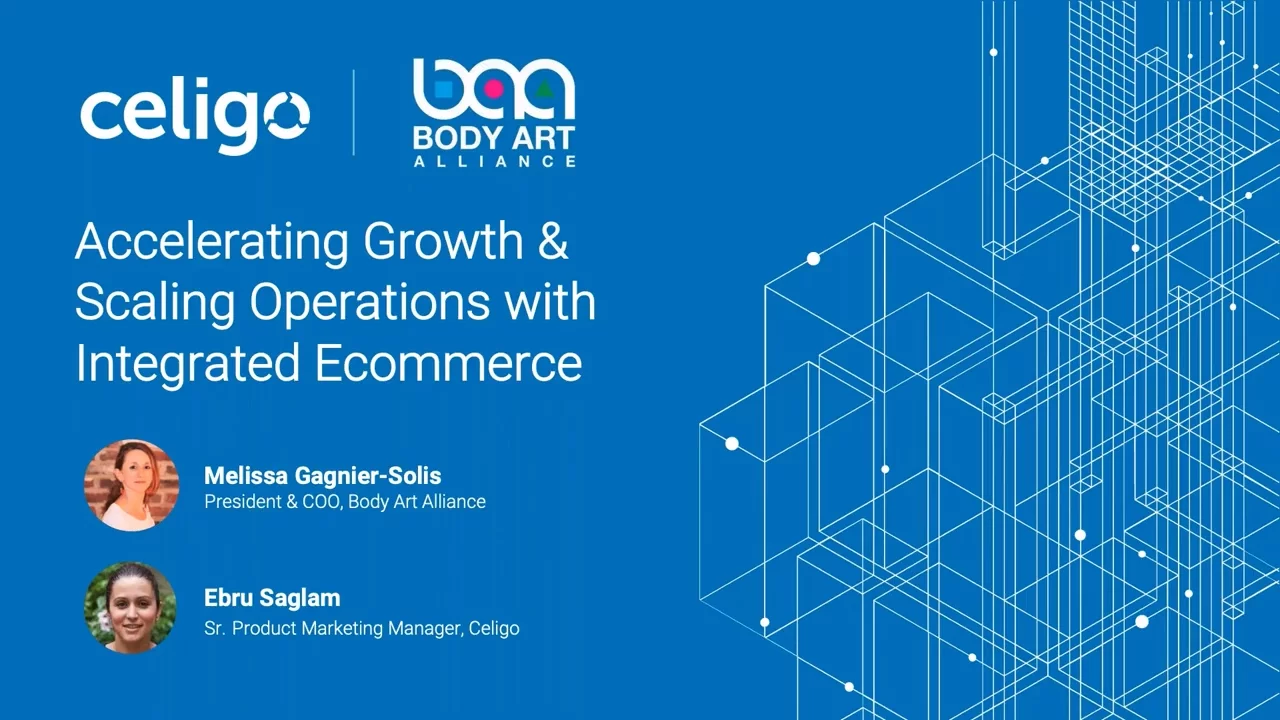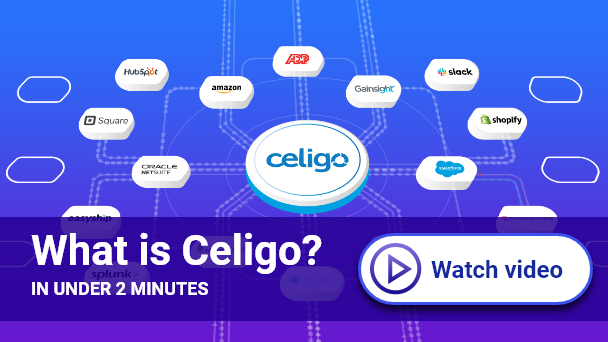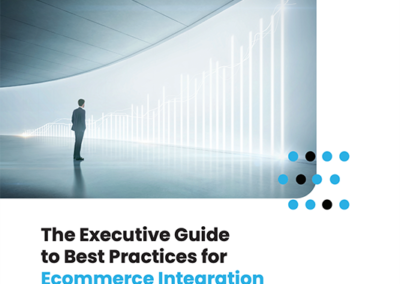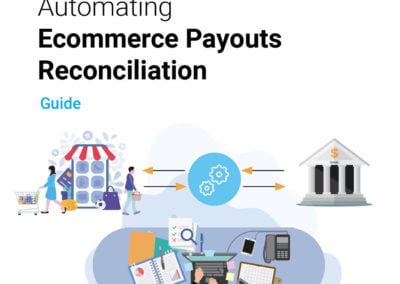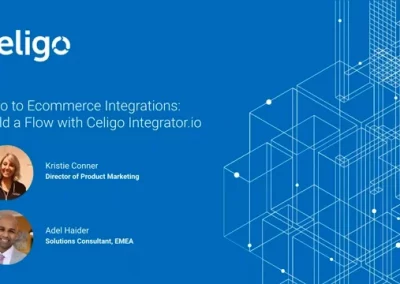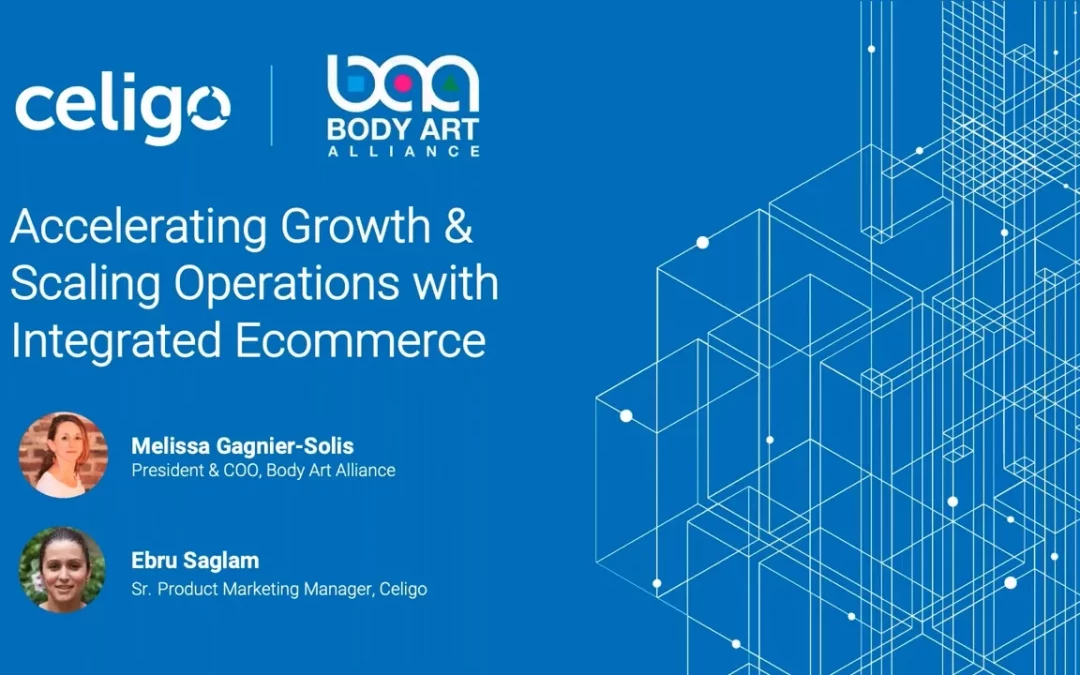Hello, everyone. Welcome to our webinar titled Accelerating Growth & Scaling Operations with Integrated Ecommerce. My name is Ebru Saglam, and I am a product marketing manager at Celigo. So I will be your host for today. Before we get started, some housekeeping items. So if you have any questions during the webinar, you can submit them through the questions pane. And we will have a Q&A at the end of the session, and we’ll be answering your questions. So our speaker and guest today is one of our great customers. So Melissa is the president and COO of Body Art Alliance, and she oversees operations and work to maintain, build, and streamline processes at Body Art Alliance. And she has a background in environmental engineering and project management engineering with a master’s degree. So before Body Art Alliance, Melissa joined the Peace Corps. And she designed sewer systems and wastewater treatment plants, and worked her way into e-commerce full time in 2011 as COO of Painful Pleasures. So today, Melissa will talk about Body Art Alliance’s system architecture and how their ERP system is integrated with their growing number of e-commerce sales channels and warehouses, and how all of this helps the company scale their operations and accelerate growth. So before we get started, some background on Celigo. We are an iPaaS, integration platform as a service, company. So today, we have more than 4,000 customers across software, retail, manufacturing, and wholesale industries. And currently, over 12,000 business processes are automated on our platform, and six billion records are synched every month on our platform. So we are a global company, with our headquarters in San Mateo, but we also have our European headquarter in The Netherlands. So on the platform, any app can be connected to any other app for having unified data across systems and also to automate business processes. So as an example related to e-commerce, Shopify can be integrated with NetSuite ERP system to automate order to cash business processes. So this way, whenever a customer order is received in Shopify, the order is synched to NetSuite for fulfillment. And once the order is fulfilled, fulfillment information along with tracking information is synched back to Shopify, providing customers real-time visibility into their order status. So that was just a quick example. And so now, having done the intro, I would like to hand it off to Melissa. Melissa, it’s all yours now. Thank you. Okay. Thank you so much, Ebru. I really appreciate it. First of all, I’m going to go ahead and talk a little bit about how we got to where we are, go through some of the history of the Body Art Alliance, and really, as Ebru indicated, where I came from. And so back in 2011, I started at a company called Painful Pleasures. And at Painful Pleasures, what we do is we sell tattoo supplies, piercing supplies, medical supplies for the tattoo and piercing industry. At the time when I joined, we had seven employees around 30,000 SKUs and small company, but doing okay. And what I really did over the course of that first six years that I was there, it was a lot of SKUs, not a lot of processes, not the right people and so I started by really understanding and building out the business. And the goal was really part of what we’re talking about today to streamline and operate so that we could scale and grow. Because I had a vision starting at this small company that one day we would be the largest, one of the largest tattoo suppliers within the United States, body jewelry suppliers. And so our journey went along and back in 2016, well, really 2015, I went on the journey of identifying an ERP system. What ERP system were we going to use? We spent around three months looking around and really trying to understand what we were going to use and how we were going to use it and why we were going to use it. And so with that journey, we identified NetSuite. Really wanted something in the cloud, didn’t want to have something on site, and I wanted something that we could manage without a big IT staff. Also looked at Celigo. We were in the version prior to this integrator,io version that they have today. It was a lot more complex and cumbersome. So I was super happy in 2017, 2018 when we switched to the integrator.io. And so really we researched, looked around and happened upon Celigo as well. Interviewed a few integration companies and there we have it. That was our choice and we moved forward. At the time we didn’t have that many e-commerce sites. We just integrated Painfulpleasures.com or eBay, Amazon businesses really using the Celgo model. And then what did Celigo allowed us to do? It allowed us and we’ll go through this a little bit later. But really, it opened up the ability for us to launch multiple sites and have that all integrated into one system. That was the really big challenge for Painful Pleasures. Well, move forward a few years in 2020, we decided to form the Body Art Alliance and what the Body Art Alliance is, several companies coming together within that tattoo and piercing industry. Painful Pleasures, as you can see some of the logos here, World Famous Tattoo Ink, FK Irons and Neon Metal all joined into a partnership together and the goal was to really provide the best products, the best value, the best experience for customers within the industry, within the tattoo, piercing and body jewelry industry. And so what do we need to do that? We came into these businesses, FK, World Famous and like a lot of small businesses and when Painful Pleasure started, they didn’t have the systems and processes in place in order to scale and grow. It’ you’re throwing a dart at the wall and you’re trying to see if it sticks. And so we took a step back when we started this partnership and alliance and said, “Well, what is it that we need for these businesses in order to scale and grow?” And Painful Pleasures did it well. We use the technology. We used the infrastructure. We chose things that we were able to apply to other businesses as well. And so we really spent that first year implementing the systems within these businesses in order to drive us forward. And so I’m going to talk a little bit about these four guys on the screen. You got Lou, from right to left, Lou, Gaston, Mark and John. And these are the founders of these businesses. This is really the heart of the Body Art Alliance. They built these brands, they built these businesses, and they did it with a lot of heart and love. And so what we were really able to provide when we formed the alliance is this structure, right, the structure with NetSuite, with Celigo, with our e-commerce platform, Shopify, Magento, with the marketplaces that we’re selling on, Amazon, eBay. And so the tattoo and piercing industry and body jewelry industry are really fragmented, and so there is the opportunity to join forces and to make something bigger than we could by ourselves to help drive the tattoo and piercing and body jewelry industry forward. And so I’m just going to talk a little bit about what those businesses are, a little bit about what they do, and a little bit about the channels that they drive on. And I say a little bit because there’s so much depth in each of these businesses, it would be hard to cover in a half an hour time period. So FK Irons is a business out of Miami. And what they do is they manufacture tattoo machines, and then they sell tattoo machines. And it’s like the Apple of the tattoo industry from a machine perspective: high end, high quality, a lot of control over how they’re building these things. Then you move over to South Carolina. We have a few locations there, and they are manufacturing tattoo ink from start to finish. And then we move over to New York. We have a shop in SoHo, and we are selling out of there. We have a little small shop there that we’re selling out of as well as providing tattoo and piercing services. Then we move to Hanover, Maryland, which is in the heart of Baltimore-D.C. area, up 95. And we are distributing out of that facility. We moved a lot of distribution, because that’s what Painful does well, to that facility. In 2020, through the pandemic, we took the opportunity to streamline several of the different operations we have across the businesses. Then you move on to the West Coast, and we manufacture body jewelry and distribute it out of that facility over in California and Washington state. And so I’m telling you that a little bit because it shows you the complexity of some of the businesses and the dynamics of what you have to do from a systems standpoint in order to run those businesses and run them successfully. They’re all operating independently on their own, not a lot of systems in place, not a lot of controls in place. And so how do you bring a system into a place that doesn’t have a lot of systems and processes? Well, you start with a major cultural change, right, because you’ve got to get people on board to be able to do that. So people is number one, that cultural shift is number one. And putting the system into place in order to shift the mindset incrementally over time, because it doesn’t all happen at once, is really what drives and is driving the Body Art Alliance forward. As this indicates, we do sell through multiple channels. So each of those different businesses has multiple sales channels. We’re selling wholesale, we’re selling B2B, we’re selling B2C. FK has three websites plus a distribution channel. World Famous has two websites, two of which we created in the past year, plus their distribution channel. Then you move to Painful. It has, I think, 12 different channels that it sells across. And then you have your conventions. I didn’t mention the conventions. You have your conventions that we’re going out to. We have, actually, three shops. I mentioned one of the three, and then on the West Coast, we have the one e-commerce channel plus distribution channels. And so I’m layering all of that because it shows the complexity and the number of channels that you have to go through, the number of distribution centers that you have to manage, and how you can do that on a daily basis by utilizing the technology. By utilizing NetSuite and Celigo and Shopify and Magento. And so one of the other points is we do fulfill all of our orders. We have all of our different distribution centers. And 2020 was really about optimizing where we’re fulfilling out of. 2021, we’re continuing on that journey. So I mentioned a few operational challenges. I’ll go into them in a little bit more depth. That complex system that we have going on. Seven different locations, the conventions, the storefronts, inventory, the number of SKUs that we have, is a big operational challenge. How do we manage all of that inventory across all of the different sales channels, ensure that our e-commerce channels are up to date with the appropriate inventory at the appropriate time, and are not stocking out of things? Will we do that with utilizing Celigo, the inventory flow. Can we utilize NetSuite, which is our ERP system? If some of you are familiar with that, we use OneWorld, which allows you to have multiple subsidiaries, multiple locations, manage things across the complex business that we have. And so we do have 45,000 SKUs. Those 45,000 SKUs are sellable SKUs. In addition to that, we have the whole operational challenge of 15,000 additional SKUs that we’re using to make some of those 45,000 SKUs. Because we’re making tattoo machines, we’re making tattoo ink, we’re making body jewelry. And so we’re utilizing NetSuite as our ERP system and the advanced manufacturing capabilities in order to do that. And this really happened over a pretty short period of time. We partnered with these businesses in January of 2020 and we went live with the first DRP– painful back in 2016, but with FK, early 2020, February 1st, and then with the other businesses through the pandemic. As everything was shutting down, we were going live on our ERP systems remotely, which was in itself, a really, really big feat because everybody was learning to be remote and then trying to do an ERP implementation remotely. It was, I can tell you, two to four weeks that I really didn’t sleep very much. So the other thing is 17 e-commerce storefronts. We have a lot of sites that we’re selling off of. There’s a lot of opportunity within the industry. There’s also a lot of opportunity for some of this consolidation. We’re figuring that out from the sales and marketing standpoint. But we said, “Oh, my goodness. We want to launch these things. How are we going to go about doing it?” We did it and are doing it. We launched three e-commerce sites this year and then also started on Amazon, FBA, and then a few other Amazon channels. We did it because we have Celigo in place. We did it because we have NetSuite in place. We did it because we have the technology to be able to launch e-commerce sites relatively quickly. And we did it because we have the right people and infrastructure in place and critical time to launch for new online sales. I mean, we are able to send products from our NetSuite system through Celigo using the product flow and shoot different content and SKUs to several channels at the same time inventory. And so it allows the team to be flexible and agile and to move quicker than you’d be able to move otherwise, rather than having to go into 17 different channels to try and update the inventory. We’re doing in time through the integration. Maintaining order, processing speed, and quality with increasing order volumes. I mean, everybody knows it’s a challenge. I mean, over the past year, trying to find people to work in warehouses has been extremely challenging through the pandemic. And it’s continuing to be at a few of our facilities. And I’m sure a few people can relate to that. But when you’re looking at maintaining that order processing speed, you need to bring those orders in from the e-commerce site. So you need to be able to enter them in quickly into your system if you’re entering them in. But the order flow from Celigo really allows us to bring in all of the orders on a– we have it on 15-minute increments. 15-minute increments from all of the different e-commerce channels. And one of the things that I like is it also allows you to see where processes are failing because it’s not going to send an order through with an incorrect SKU. And if you have a POS system, if you don’t have the proper controls in place– and as a growing business, some of these things you kind of learn as you go. You confront the challenges and then you put the process in place. We find that Celigo will let us know when there’s an issue which has been really, really helpful, especially with going from 60 employees to 350 employees in a matter of months. Up to date and visibility into inventory levels and finances. You can run a report in that suite and we do daily reports to figure out, “Okay, how did we do yesterday? What kind of visibility do we have in our business? And we have pretty much in-time visibility into how our businesses are doing because all sales are running through different channels, but they’re all coming in into Celigo. And so just a little bit about the system architecture for e-commerce automation. I mentioned it a little bit previously, but this is a really nice graphic on, what does it look like? Well, we have NetSuite as our– this is our like master record. This is true to who we are, and what we do on a daily basis. This is where everybody goes in to operate and know about the business. We use it from a warehousing perspective. And you can see the little arrows to RF-Smart. We just implemented an RF-Smart system this year in our warehouses. We went live two weeks ago across two of the warehouses and over the course of the next month, we’re going to go live in all of our warehouses. We’re paper-based and will continue to be as we transition into the digital world with RF-Smart. So really, you have your warehousing, your inventory management, order to cash, all of your sales orders, your cash sales, your invoices, procure to pay. We’re using it for purchase inventory. So everything is tied into one. And then you’re doing a bunch of other transactions, all your expenses for the business, all of your– all the travel that people are starting to do again. And so really everything is tied into NetSuite as our true source of business. And we’re using Celigo in the middle to integrate with a bunch of different things. And those things for the Body Art Alliance are Shopify, Amazon, Magento, eBay. And so we’re really selling across, I said 17 channels. We have many in Shopify and many stores in Magento. And Magento is moving to Adobe Commerce. But we are moving towards the Shopify solution. And the reason we’re doing that is because it’s easier. It’s plug-and-play. It’s got better data. And Adobe Commerce or Magento hasn’t been able to keep up with the technology. It wasn’t the same way 10 years ago. But that’s what we’ve been in the back end trying to decide as a business, “Okay. What technology do we want to use?” And we can’t stay stagnant. We’ve always got to keep looking at what we’re doing, how we’re doing it, and ensuring we’re making the best decisions moving forward. A year ago, I thought we were going to be a Magento company. Today we’re moving towards Shopify. What I really like about Celigo is it continues to innovate and come up with new solutions for customers. And so if you move to the next slide, Ebru, one of the things that we’re doing is we’re utilizing the– and this is just for Shopify. We’re utilizing all of the different flows in order to pull in and time information into business. And so you can see Celigo has multiple flows, has a customer flow that basically when somebody comes into Shopify and signs up whatever attributes you decide to select in Shopify that you want to match over to NetSuite you map them and it comes over. You have your order flow, same thing. In time every 15 minutes that order will come over unless– and create a sales order or cash sale or invoice depending on how you have it set up, unless, of course, the human makes an error when entering an order. If they so happen to enter in a POS system then you have your fulfillment flow. What I really love is that Celigo will– you ship something in NetSuite and then it pushes that tracking information in time on a 15-minute incremental basis or half an hour or whatever you decide and select and it tells the customer, “Hey, this has been fulfilled. And go ahead and notify the customer.” You have your product flow and then same kind of thing, you can put an item into NetSuite and that pushes that over into Shopify, your billing flow to create those cash sales and invoices with the payment methods that you select, your refund cancellation flows, and then your inventory flow where this is– this was magic for us because prior to NetSuite and Celigo, we had a major issue with out of stocks because we sell on multiple channels. Selling on multiple channels makes it really challenging to take care of inventory, keep in time inventory if you don’t have a master system within integration to all of your different systems. And so another piece that we’re starting to work on because every business is continuing to grow and innovate because if you don’t then you kind of stay stagnant, we want to continue to optimize our different processes. And so we looked and we’re having trouble with, “Okay. We sign up somebody for ADP. Do we need to give them a NetSuite license? If we need to give them a NetSuite license, let’s send that information from ADP with their supervisors, their name, their correct email address over to NetSuite. And then if they’re terminated, ADP will let NetSuite know they’re terminated so we don’t have ongoing licenses and license issues. I don’t know if this has ever happened to anybody. It’s like you have a license for something and you’re like, “Oh, crap, I don’t actually need that license anymore, but I forgot about it because I’m not checking it on a regular basis.” We’re auditing these things regularly, but it takes time. And so time is obviously money. We want to be able to bring some automation within our HR department. So that’s one of the steps that we’re taking in order to do that. And so that’s actually an ongoing project right now. Another project that we’ve started is looking at the BI piece. And I don’t think there’s a slide on this, but we’re currently evaluating Celigo connecting with SEQUEL database in order to power the AI. And so through that, we are looking at and continuing to optimize and look for different solutions for the business. And here it’s how automation is helping Body Art Alliance meet our business goals. And I think I’ve mentioned a lot of these throughout the way. But I think this provides a nice summary lot. How does automation help? Well, it does help grow and scale your operations. You can’t run a business with inaccurate inventory. It’s just not possible to scale and grow. The customer service issues, the ongoing issues that you have as a result it’s not tenable. The other thing is not understanding and having visibility into in-time finances. I think that is really important, and it allows you to have the visibility to make good business decisions. Efficiently kicking off new online sales channels. We’re kicking off a new sales channel on June 30th. We just got the integration. We’ll set it up next week. But it allows us to quickly, and easily connect our systems to different sales channels, NetSuite to Celigo, or NetSuite to Shopify through Celigo. And the next thing is really eliminating human errors. Well, I talked about a little bit of those. The integrator helps and tracks human errors. It doesn’t allow things to go through as a result of somebody making a mistake. And self-service troubleshooting, I’ve run the business, the Celigo NetSuite integration through all of our e-commerce sites since 2016. And now what we’re doing is we’re empowering each of the business units. And these are not IT people, but it’s part of the team. It’s just 10 to 10 minutes to an hour, a day of troubleshooting what’s going on in the integrator. It’s usually a result of somebody making a mistake in some part of the business is why there is an error within the integration. So setting up the integrations, how do we do that easily? And then self-service, really teaching and empowering your team to be able to manage their daily operations and troubleshoot when things are going wrong. We talked about the out of stocks and inventory and really faster fulfillment for orders. How do we move forward? And we’ve been able to and capable of fulfilling orders faster due to that in-time, visibility of orders coming into NetSuite, and us being able to process them faster. Great. Thank you so much, Melissa. I guess that was it, right, from the presentation site? Yes, it is. Okay. Yeah, that’s it. And thank you. Thank you, April. Yeah. Thank you so much. That was very insightful hearing how Body Art Alliance is growing through its scalable operations. So to the audience, if you have any questions, now’s the time to type them into the questions for me. And I see there’s our first question here. So you mentioned you’re sinking in around 3 levels every 15 minutes. Does it ever happen you oversell your SKUs? How do you handle that? Yes, it does happen. And that’s something that actually we’re working on. The reason why that happens is because we do also put orders directly into NetSuite. And so we recently updated to 15 minutes. Previously, we put it at– it was an hour. We just changed this two weeks ago, actually, because what would happen as we’re growing, we’re getting more sales. We’re selling across more channels. And so our sales reps are out there selling, and they put in an order, and it overrides an e-commerce order that came in. And so what we’re doing in order to address this is, on a daily basis, we have an out-of-stock report that’s run. Usually, out of our 40,000 SKUs, it’s affecting 5 to 10 items a day, which in essence does add up over time, but it’s not super significant. And what we’re doing is, we’re addressing them on a SKU-by-SKU level. We are working with the accounting team and the operations team. We have an inventory team at each of the different locations now. It’s something that we’ve been working on over the past year of building out the proper infrastructure. And they’re communicating in time to figure out, “Okay. Why is this happening? Where is this coming from, and what’s the root cause of this, and how do we solve this?” because usually it’s a human error. It’s not an integration error. It’s somebody overwriting the system and overselling something because it’s coming from a different sales channel. Does that help? Yes. Thank you, Melissa. So another question is, you mentioned you have thousands of SKUs across your systems. So how do you create new SKUs? How do we create new SKUs? Well, we have a new SKU process that we wrote up. It’s actually evolved over time. Every business unit has a person who’s in charge of their specific SKU. And so our supply chain team at each location is in charge of creating a new item. The item is created into NetSuite, and when it’s created into NetSuite, we have several different attributes that are required to be filled out. Those attributes actually help with a lot of the reporting that is done on a daily basis in order to really get into and understand the business at a deeper level. So the supply chain person will fill out the new item record. And we utilize inventory items. We have matrix items with the sub items. We utilize assembly items. We utilize lot items. We utilize serialized items, and then we also use item groups, item kits, and non-inventory items. So right now we’re using every single item type, or not every single one because there’s more, but I feel like it’s a lot of item types that we’re utilizing. So we create that within NetSuite and, in NetSuite on the item record, fill in all of the information. At the very bottom there’s a detail channel tab, and then in that tab you indicate where you want that item to be sent. You fill out where you want that item to be sent, and then, as long as all of your mapping is correct within the Celigo platform, that item is then sent to the platform that you indicate that it should be sent to. It’s not all peaches and cream because it doesn’t always work 100% the way you want it, but it’s usually because of a human error, and they forget to put an– they forget to input a specific field. Once you get past that and you get your users trained, it actually works relatively well. We’ve been using the product flow since 2016 for painful pleasures. That was very insightful. Thank you so there’s another question. How long was the implementation process from giving the go-ahead to going live? So it depends. For Painful Pleasures, the original go-live was selected the platform in October of 2015, and we went live on April 29th of 2016. And so that’s a six or seven-month process. It was really three or four months of really hard work. And then before that, all that prework that you’re doing. the recent businesses that we have integrated, we went live with one of them in two weeks, and the other ones within three months. From an integration standpoint, I usually set those up within one to four hours, depending on what integration it is and what flows we need to set up. Usually, we start with the most important, which are the order flow, the inventory flow, the billing flow. Those are super quick, mostly out-of-the-box flows. You can watch a few videos and in relatively short order, understand how to set them up and how they’re working with the attributes that you need to map. You do need to work with your developers if you’re doing an e-commerce implementation to just get the app implemented on your either Shopify or Magento site depending on what e-commerce platform you’re using. And then some flows that are a little bit more difficult to set up that I found are Amazon. Amazon’s pretty complicated. The product flow is pretty complicated. But I usually try to start easy, and then add in flows as the business gets more sophisticated. I try not to bite off and our team tries to not bite off more than it can chew. As far as this phase two NetSuite, I mean, NetSuite’s an ongoing implementation all the time because you can always optimize and continuously improve. We’ve been working on the second phase for the past six months, and this is really bringing us into the digital age with the RF smart systems. We started at one of our facilities – what was it? – in February, and we just went live in June. And then we started at another facility in March, and they’re going to go live in July. And that’s really everybody walking around with an RF gun, scanning things rather than using that paper-based system. Great. Thank you. So there’s one more question. So the question is for wholesale and business-to-business sales, do you provide your customers personalized or custom quotes? If so, how do you handle this with your e-commerce applications? And did you have to build any custom integrations? We don’t because we have fixed pricing. So a customer, we do have two distribution portals that people have to log into. They’re not front-facing – you can’t Google and find them – portals where customers can log in, and they see their personalized pricing and they can log in. They place their orders, and then that comes through. That just comes through as a pending order. And then it has to be approved by the team within our sales team. And then once it’s approved – so we’re not using quote but we’re using a pending approval sales order – comes in, and then the sales team will approve it or not approve it because sometimes you don’t always approve the orders if you don’t have the inventory. Then they’ll go ahead and build the order, and then invoice the customer. The tattoo industry and the piercing industry is all prepaid. So we don’t have terms. So if a customer wants something, they’ve got to pay for it upfront, in general. There are some exceptions to that rule, but in general, there’s not an AR issue in the tattoo and piercing industry and body jewelry. Okay, great. And so I’ll take one final question. Okay, so let’s take this one. So what kind of preparation did you do before starting your first integration project? How did you prioritize what needs to be integrated first? So if I look back on the different projects that we’ve done, I think about what is going to have the largest benefit and most value for the business. And so I really prioritized sales orders, inventory, and fulfillment because if I have the sales orders in and I have accurate inventory feeding out to the different channels, then I understand that I’m going to not have as many customer service-related issues. From a data perspective, really, when we were all– just go back to the example where we did this implementation really in two-week time frame, it was just about having your master item records because in the business that I’m in, we sell stuff, and we buy stuff, basically. And so having your master item records accurate and aligned with your e-commerce store, making sure they match one to one with forty thousand SKUs is extremely challenging in some ways. But it’s basically you have an Excel file and you’re doing view lookups ensuring things match. And if they don’t match, then getting to the root cause of why they’re not matching and going through issue one by one, but really prioritizing your data. And I will say some people want to get their data perfect. I feel like there is no perfect, perfect, perfect data because things change. And so I would say being okay enough with the data that you have and feeling confident enough that you can go live. And maybe it’s not 100% accurate, then maybe it’s 95%, and you can get the 5% the rest of the way as you go through your implementation and as you go live. It’s never going to be perfect. There’s always going to be hiccups. And you just have to be able to tackle each hiccup as it comes through. Thank you so much, Melissa, for sharing all your experience with our audience today. So that was a great presentation and great insights. So for the audience, if you have any questions after the webinar, please feel free to email us at
[email protected]. And also you can visit our website, celigo.com, and learn more about our business process solutions and integration solutions. And we’re also interested in hearing about your integration challenges and business challenges. So feel free to reach out to us. So thank you, everyone, for attending them. And thank you again, Melissa. This was great. Bye, everyone. Yeah, thanks. Bye.
